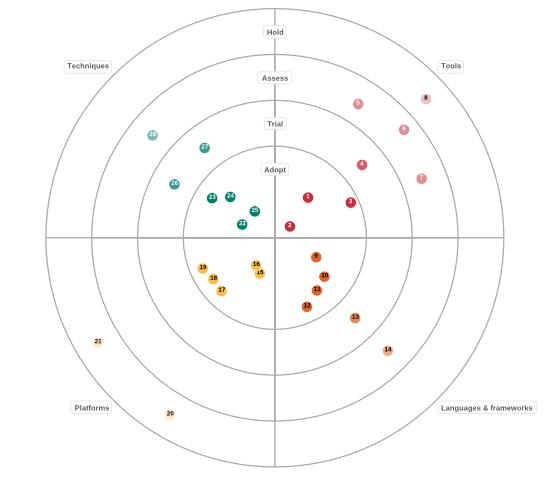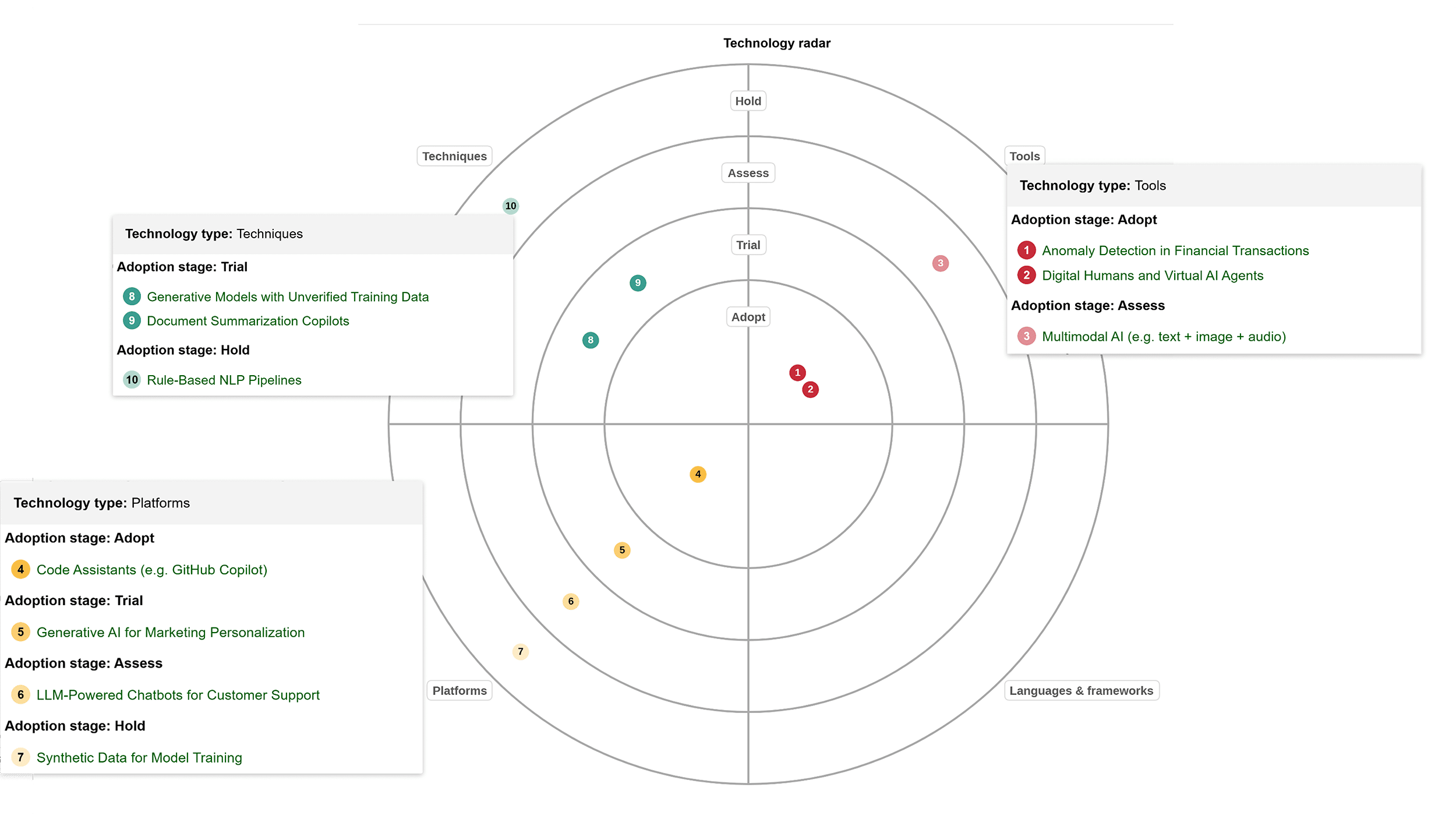Found this helpful? Share it with peers.
Introduction
AI technologies are entering organizations faster than most teams can process. New tools, models, and methods appear constantly, but there’s rarely a clear system to evaluate them. Many move forward without knowing what to adopt, what to test, and what to avoid.
This blog introduces the AI Technology Radar: a way to bring structure to AI-related decisions and track what matters across technology, platforms, and practices.
What Is a Technology Radar for AI?
A Technology Radar for AI is a strategic tool that categorizes technologies based on:
Adoption readiness
- Adopt: Proven and ready for broad use
- Trial: Worth piloting in specific contexts
- Assess: Emerging and exploratory
- Hold: Risky, unproven, or outdated
Type
- Techniques: Approaches, methods, or practices
- Tools: Software or services for AI development, deployment, or productivity
- Platforms: Foundational environments or AI service layers
- Languages & Frameworks: Programming ecosystems and libraries for AI
Each technology or use case is placed in a quadrant (sector) and ring based on its relevance, maturity, and potential for your business.

Example of a Technology Radar
The Four Radar Rings Explained
An AI Technology Radar categorizes technologies by placing them into one of four adoption rings. Each position reflects how the organization is working with the technology, including prior experience and how feasible further use appears to be. In practical use, this structure supports decisions on what to adopt, trial, assess, or hold.
Each of these rings plays a distinct role in guiding how AI is reviewed and introduced to the organization.
Adopt – AI That Delivers Value Today
This ring includes technologies that are mature, have robust ecosystems, and are already delivering measurable value. They can be safely rolled out at scale.
Examples:
- Copilots for document generation
- Code generation tools
- LLM-based customer support chatbots
Trial – AI You Should Experiment With
Technologies in this ring are promising, but still require validation within your context. Targeted pilots can uncover fit, feasibility, and business value.
Examples:
- Synthetic data generation
- Generative AI for product descriptions
- AI for fraud detection
Assess – AI to Watch and Explore
This ring includes early-stage innovations that are still under development. While not ready for broad deployment, they indicate areas where technical progress is accelerating. Limited pilots can help clarify their relevance and inform future decisions.
Examples:
- Multimodal AI (text + image + audio)
- Digital humans for support
- Causal AI for explainability
Hold – AI to Pause or Avoid for Now
These are technologies that are obsolete, too immature, risky, or ethically questionable. Investing in them now may lead to rework or reputational risk.
Examples:
- Rule-based NLP
- Black-box generative models with unverifiable data
- Monolithic chatbot platforms without adaptability
Example: An AI Technology Radar in Practice
Here's how a real-world AI Technology Radar might look. It highlights 10 representative items across the four sectors and adoption rings. You can use this layout as the basis for a visual radar.
AI Technology Radar in ADOIT
| AI Technology / Use Case | Ring | Sector | Why It’s Placed Here |
|---|---|---|---|
| Document Summarization Copilots | Adopt | Tools | Ready for broad use across legal, HR, and internal documentation processes |
| LLM-Powered Chatbots for Customer Support | Adopt | Platforms | Matured significantly, showing clear efficiency and satisfaction improvements |
| Code Assistants (e.g. GitHub Copilot) | Adopt | Tools | Popular among developers, delivers clear productivity benefits |
| Synthetic Data for Model Training | Trial | Techniques | Key enabler in privacy-sensitive domains like finance and healthcare |
| Anomaly Detection in Financial Transactions | Trial | Platforms | High-impact use case with increasing feasibility |
| Generative AI for Marketing Personalization | Trial | Techniques | Used in digital commerce, strong early results in content and conversion optimization |
| Multimodal AI (e.g. text + image + audio) | Assess | Platforms | Emerging area with strong future potential but technical and integration complexity |
| Digital Humans and Virtual AI Agents | Assess | Tools | High novelty; currently held back by trust, latency, and regulatory uncertainty |
| Rule-Based NLP Pipelines | Hold | Techniques | Widely considered obsolete due to transformer-based models outperforming them |
| Generative Models with Unverified Training Data | Hold | Platforms | High risk in compliance, ethics, and brand safety |
How to Build and Use Your Own Radar
Creating a radar is not a one-time effort. It requires ongoing discussion between business and technical stakeholders to keep priorities clear and up to date. The following steps show how to structure the radar and embed it into regular decision-making.
1. Define Your Radar Scope and Sectors
Decide if your radar will focus purely on AI or a broader tech scope. Keep the four-sector model: Techniques, Tools, Platforms, Languages & Frameworks or adapt them to the needs of your organization.
2. Run Discovery and Alignment Workshops
Involve architecture, product, innovation, and operations teams. Ask questions such as:
- What are we using already?
- What's being piloted?
- What's being talked about – but not yet acted on?
- What's obsolete or risky?
3. Place and Prioritize
Business relevance
How directly the technology supports strategic priorities or addresses pressing needs in the organization.
- Does this technology contribute to a specific strategic goal or business capability?
- Is there a clear problem or opportunity it helps address?
- Can we link its use to measurable outcomes or value?
Technical feasibility
Whether the existing infrastructure, skills, and architecture can support implementation or experimentation.
- Do we have the necessary infrastructure or skills to work with this technology?
- Would adoption require significant changes to existing systems or processes?
- Can we test or deploy it without major dependencies or delays?
Risk and readiness
The potential impact of failure, including compliance or reputational concerns, as well as how mature the technology is for real-world use.
- What would be the impact if this technology fails or underperforms?
- Are there known risks related to security, compliance, or trust?
- Is the technology proven in similar environments, or still in early development?
Strategic alignment
How well the technology fits with long-term plans, architectural direction, and enterprise priorities.
- Does this technology support our current or future architecture model?
- Is it compatible with planned platforms, standards, or sourcing strategies?
- Will it remain relevant as our strategic direction evolves?
4. Share and Iterate
Use the radar to communicate which technologies are under consideration and how they relate to current work. This creates a shared reference that supports discussion across teams.
Refer to the radar when allocating budgets, planning onboarding, or preparing for vendor decisions. It helps narrow the focus to what is already being tracked and avoids spending effort on unrelated tools or proposals. Over time, this turns the radar into a working instrument rather than a static overview.
From Radar to Roadmap
The radar becomes most effective when it informs planning. Once technologies are placed and reviewed, the next step is to connect them to specific actions. This may involve starting pilots, assigning work packages, or adjusting architecture priorities.
Items in the adopt or trial ring can be linked to roadmaps that guide capability development or technology rollout. Entries in the assess ring may point to areas that require further investigation or targeted training. Technologies marked as hold can help identify what to phase out or avoid repeating in ongoing projects.
This approach ties the radar directly to planning cycles and keeps attention on technologies with clear relevance or impact.
Hint: Learn how to build long-term plans around capabilities, initiatives, and IT portfolios with our guide to strategic roadmapping.
Final Thoughts: AI as Part of the Architecture
An AI Technology Radar brings structure to technology evaluation. It separates tools that are ready for use from those still under review or no longer relevant. This helps determine where to move forward and where to step back.
In ADOIT, each radar item can be connected to architecture elements such as business capabilities, application components, or work packages. These links add context and traceability, helping teams evaluate new technologies within the structure of ongoing plans.






